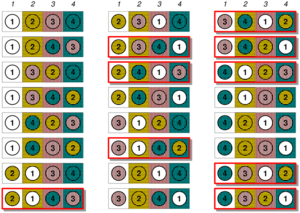Derangement (nonfiction)
In combinatorial mathematics, a derangement is a permutation of the elements of a set, such that no element appears in its original position. In other words, derangement is a permutation that has no fixed points.
The number of derangements of a set of size n, usually written Dn, dn, or !n, is called the "derangement number" or "de Montmort number". (These numbers are generalized to rencontres numbers.) The subfactorial function (not to be confused with the factorial n!) maps n to !n.
No standard notation for subfactorials is agreed upon; n¡ is sometimes used instead of !n.
The problem of counting derangements was first considered by Pierre Raymond de Montmort in 1708; he solved it in 1713, as did Nicholas Bernoulli at about the same time.
In the News
Fiction cross-reference
Nonfiction cross-reference
External links:
- Derangement @ Wikipedia
